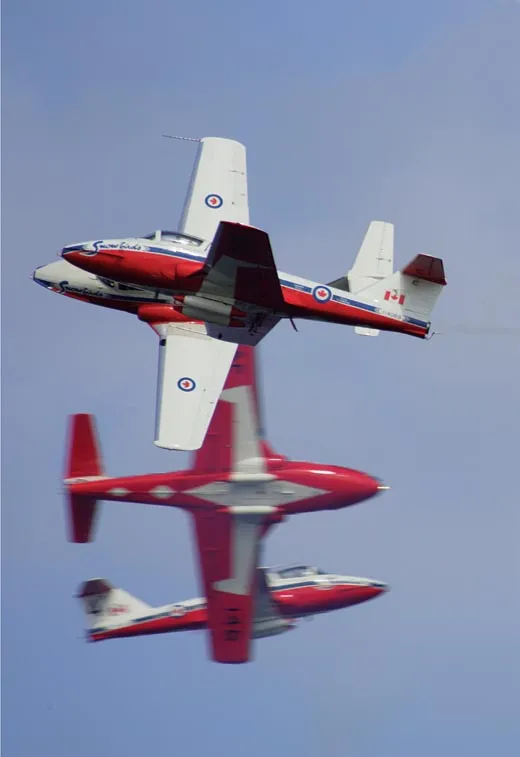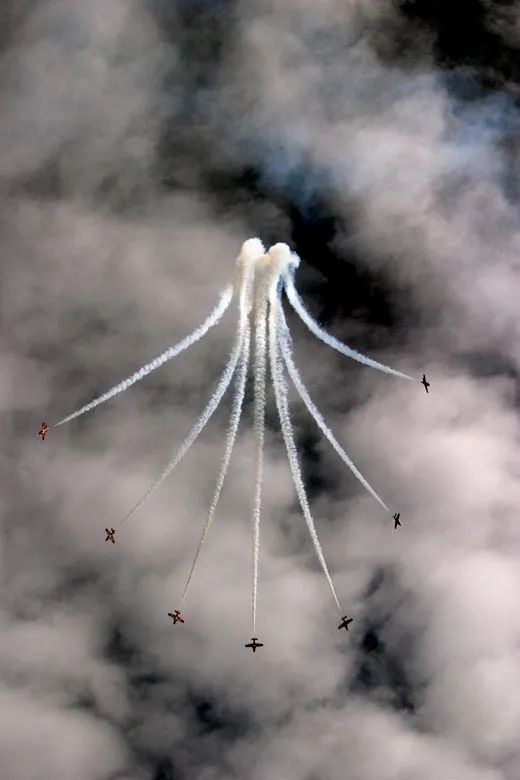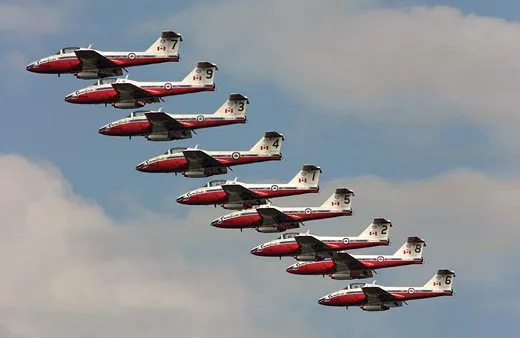The Moose Jaw Nine
What the Canadian Snowbirds have that the Navy’s Blue Angels don’t.
/https://tf-cmsv2-smithsonianmag-media.s3.amazonaws.com/filer/3d/e9/3de968d9-986a-4f24-a832-348ccfd9079b/ebf00b4f-2bc0-4e6f-b2ea-0938cec158f6.jpg)
I’m in the left seat of Snowbird No. 4’s aircraft as the team practices an arrowhead loop formation over a flat January landscape the color of faded wheat near its home base of Moose Jaw, Saskatchewan. On the pullup and during the float over the top, I keep an eye on Snowbird No. 8, Captain Mark LaVerdiere, the outer wing man, three airplanes away on my left. He maintains his position but there’s a bit more movement than I’m seeing from the aircraft to my immediate left. As we come down the back side, with the call “Power coming up” from the lead aircraft, I try to picture what it must be like keeping LaVerdiere’s outer wing position in a nine-aircraft line-abreast formation. Like the end of a crack-the-whip.
I’m flying with Captain Dave Boudreau, who is the first line-astern position with Canada’s 431 Air Demonstration Squadron, better known as the Snowbirds. It’s the first half of practice season, and the team hasn’t yet worked up to its nine-airplane formations. But when it does, airshow announcers could well alert the crowds with the Monty Python introduction: “And now for something completely different.”
The Snowbirds don’t even try to mimic their U.S. counterparts, the Navy’s Blue Angels and the Air Force’s Thunderbirds, who fly top-of-the-line jet fighters. There are no high subsonic afterburner-blasting passes; Snowbird performances aren’t about blinding speed and chest-thumping military might. They’re designed, quite simply, to keep the crowds entranced with their formation routines.
The team is as distinctly Canadian as the “snowbirds,” the northern folk who flock to Florida and other warm points south each winter. “When I was a kid I had two goals,” says LaVerdiere. “One was to be an NHL hockey player and the other was to be a Snowbird pilot.” Most Canadians view the Snowbirds as a national icon, part of the country’s character. “When you talk to people after shows in Canada, you’d be surprised at how many don’t know we’re a military organization,” says Major Cory Blakely, Snowbird No. 3, inner left wing. “In a large way, they identify us as a truly Canadian thing.”
As the Snowbirds charge into their 37th season this year, their airplanes don’t look or even feel old. The primary jet trainers are built solid enough to withstand student overstressing and mishandling, and they’re extremely well maintained, spotless, and beloved.
Designed by Canadair in the late 1950s, the CT-114 Tutor first flew on January 13, 1960—well before the elders of today’s fighter community, the F-16s and F/A-18s, were even on a drawing board. Yet the Tutors may continue delighting the crowds until 2023, says the Bombardier company, which now owns Canadair. No longer operational as air force pilot trainers—they were replaced in 2000 by Raytheon CT-156 Harvard IIs and BAE Systems CT-155 Hawks—most of the 190 that were built are used to train maintenance teams. “It was an ideal [pilot] trainer because of the forgiving handling characteristics and excellent slow-speed qualities,” says Blakely, who trained in the Tutor and is now in his fourth year as a Snowbird. “It affords the ability to fly at higher speeds for transition to higher-performance aircraft, and it’s a very good aerobatic airplane.” He says the side-by-side seating allows a clearer explanation of instrument flying than front and back seating. “By the same token, it’s an excellent training aircraft for new Snowbird pilots,” he adds, “allowing the instructor Snowbird to make direct observation of the control inputs of the fledgling Snowbird.”
The Tutor can turn on the proverbial dime, and it needs only 4,000 feet of runway, so the team can perform at remote villages like Fort Smith, Northwest Territories, population 2,600. “The Tutor is perfect for formation flying—low power and a great roll rate,” says Blakely. “So we can keep it tight and right in front of the crowd. Unlike a fighter, we can get turned around pretty quick.” Which doesn’t go unnoticed by other teams.
“What’s impressive to me is seeing all those nine aircraft flying in a delta formation or flying in a line-abreast formation,” says Lieutenant Commander Anthony Walley, Blue Angel No. 2. “I mean, that is incredible. Since it’s a smaller aircraft, they can really get into some tight formations, and from the crowd’s perspective it looks like they’re right on top of each other.”
With the smaller, more nimble airplanes, Walley says, Snowbird pilots can take advantage of the tighter turn radius. “You can do a lot more of your transitions and formation changes in front of the crowd,” he says. “For whatever reason, we’ve always done our formation changes behind the crowd. I think one of the reasons now is that the F-18 just doesn’t have as tight a turn radius as the Tutor.”
The slow speed and tight formations of the nine Tutors give the Snowbirds a different combination of options. The team used to do nine-airplane formation takeoffs and landings, but Blakely says these difficult maneuvers have been shelved, “based on a ‘risk versus reward’ analysis. The takeoff-and-landing runway is not always aligned with or visible to the crowd, so exposing the aircrew to elevated risk was deemed unnecessary.”
Still, the team likes to open and close with nine-airplane maneuvers. “It can be difficult to get the nine-plane together once it’s apart,” Blakely explains. “The opener [segment] will typically be about 12 minutes long and will usually involve two or three loops or rolls in the nine-plane formation. In between those rolls, there’s a presentation of either a bottom side pass [presenting the aircraft underside to the show line] or a top side pass as we go by in some different formation, like a nine-plane line-abreast. The closer is somewhat shorter, and again involves two or three loops.”
The nine-airplane line-abreast looks straightforward, but “any time you add more aircraft on anyone’s wing on a line-abreast maneuver, you’re increasing the difficulty,” says Blue Angel Walley. “More so for the the guys on the outside, because you have to look through the movement of the guys on the inside, and still try and maintain your position on the [lead aircraft] best you can.”
The Tutor lacks the high thrust-to-weight ratios of the U.S. teams’ aircraft. The Canadian team compensates with creative flying techniques. “We’re always power-critical,” says Blakely. “So we tailor our profiles to those thrust limitations. On a hot day in a high-density altitude, we really earn our money staying in formation, particularly the guys on the outside and the second line-astern.” (The higher the terrain and the hotter the temperature, the thinner the air, which results in a decrease in aircraft performance.) He explains how they take advantage of a visual illusion. “Our line-astern guys are stacked underneath the boss, so the second guy is a good 20 feet outside the turn radius of the inner plane when they pull up into a loop. On a high and hot day, he’ll probably not have enough power to maintain his position all the way around a standard loop.” Blakely explains that those pilots will slide their aircraft forward until the nose of one overlaps the tail of the other. “We call this vertical stacking,” he says. “That geometric difference allows them to have enough power to stay all the way around and be basically all overlapped on the back side of the loop.” Another Tutor restriction is credited with creating one of the Snowbirds’ unique maneuvers, the Double Take. It came about as a direct result of an engine limitation. The aircraft can be flown inverted for a maximum of 20 seconds before G forces hamper fuel flow. (Current U.S. fighters can manage for 30 to 60 seconds.) Starting in a four-airplane diamond formation, the lead and the first line-astern are right side up, and the inner pilots roll upside down. As they fly past the crowd, the entire formation rolls through 180 degrees so that the inner pilots are right side up. A simple non-rolling flyby would take longer than 20 seconds; rolling through 180 degrees allows them to beat the restriction.
“It’s one of my favorites,” says Blakely, “but also the most difficult. First, flying upside down means reversing the controls—if you want to turn left, you move the stick right, and vice versa—and it really takes quite a while to train your brain for that process. The second thing is when we roll around, you have to actually push 2 negative G. Now you’re maintaining formation with reversed controls as the world is spinning around at minus 2 Gs.”
Snowbird pilots use heavy nose-down trim when performing difficult maneuvers, especially when in turbulence. Holding back pressure on the stick stabilizes the right arm, enabling a pilot to maneuver using only pressure instead of large movements. The Blue Angels don’t have that luxury. LaVerdiere, who flew Hornets, says, “With the F-18 you can’t—the computer will constantly override you trying to do that, so my hat’s off to them.”
Unlike U.S. military team performers, who are fighter pilots, the Snowbirds hail from all walks of military flying. Two of the current team flew Sea King helicopters. Boudreau flew Aurora maritime patrol aircraft, a version of the Lockheed P-3 Orion. Still, the average Snowbird pilot is 36, close to his U.S. counterpart’s age.
When Walley showed up at the Blue Angels in September 2005, he had already been selected for the 2006 team. “You still have the existing year’s team at several airshows until the end of November,” he says. “You sit in the background, listen, learn, ask questions, and study. Once you find out what position you’ll fly, you shadow the individual you’re going to be filling in for. It’s a humbling process.” Come November, “the old guys leave and you jump into the mix.”
Arrival at Moose Jaw was different for new Snowbird opposing solo Mark LaVerdiere. Being a fighter pilot was almost a disadvantage: His squadron was a little short on pilots and was hesitant to release him from flying F/A-18s for a few years.
The Snowbirds select two candidates for each new position, so LaVerdiere had a competition to sweat through first. “You fly with all the team members and they assess you,” he says. “Nine flying days, two and three times a day.” Candidates must record their own errors each flight. “You focus on your own mistakes for two weeks,” he says. On the 10th day a winner is announced.
LaVerdiere is now a member of a squadron that consists of just 20 aircraft and 85 pilots and technicians. Unique to the Snowbirds, the technicians travel from show to show in the nine show aircraft, alongside the pilots. “It’s the most amazing thing to be able to travel in that role,” says Sergeant Marlene Shillingford, the Snowbird’s new crew chief. “Being in the same airplane, having all the formation around you, is a great advantage. We usually fly three aircraft at a time, 10 minutes apart—the coordinator flies in the first group so he’s there on the ground first at the airshow site.”
There’s no support airplane like the Blue Angels’ C-130 Hercules Fat Albert. Spares travel in a truck called the Mobile Support Vehicle. “We carry most of our parts and tools in the MSV, including two spare engines,” says Shillingford. She says her crew can change an engine in four hours.
And those parts, one might think, would be hard to find today. But “we’ve never been short an airplane for a show due to unserviceabilities or parts shortage,” Shillingford says. The lowest-time Snowbird Tutor has just 6,500 hours; it could yet go a long way. The squadron’s highest-time aircraft has logged well over 12,500.
The team will perform at eight U.S. sites this year. A U.S. Snowbird appearance guarantees huge crowds, who are as thrilled as the Canadians by the nine little jets, all in a row.


